Xorryaddans are 5 or more species of genetically compatible aliens who escaped from an apocalypse in an incredibly far away solar system. They recently moved in as planetary neighbors to Daejiin and Sphinxoids. Warning for nudity ahead!
| x |

txt

Xorryaddans evolved as apex predators on their original planet, featuring sharp beaks and teeth built for crunching flesh and bones. Their ocular organ is set inside their skull above their mouths. Their bones and skin function as one-way glass. This allows them to see almost 360 degrees around them without needing to rotate their heads. When bright light hits their head right, you can vaguely see the outline of their skull and "eye" inside their skin.
As both technology and capitalism overtook the world, workers toiled for long hours and little pay while the rich lounged on private islands and luxury spaceships, touring outer space while being unable to care even for their homeworld. The overuse of unclean energy eventually destroyed the ecosystem, mass extinctions killing off most animal and plant species over time.
During this period, Xorryaddans were forced to evolve quickly to survive; they became radiotrophs. Radioactive byproduct from coal-like energy sources became an energy source, absorbed through the skin and converted into energy within the cells using radiosynthesis.
No longer requiring much, if any, solid food, the Xorryaddan digestive system shrank in size with disuse. A modern Xorryaddan can only eat a few bites before becoming full, usually preferring hard candies or flavor tablets instead.
As the forests disappeared and global weather spiraled out of control, the ecosystem fully collapsed, and those in positions of power could no longer stand idly by and pretend all was well.
Daily earthquakes, increasing in intensity, shook the world. Anomalous screams rang out periodically, audible across the globe. "We can't stay here any longer," most agreed. "Our world is falling apart."
Plans were made, and a paradise-like planet a few star systems away was selected as the destination. As many Xors as possible were meant to crowd into billionares' luxury spacecraft; but the billionaires and government agents began disappearing on their own, abandoning their species and fleeing the planet, leaving their citizens behind. "They never cared about us anyway."
The richest Xor in the world, owner of the world's first megastructure-sized spacecraft was preparing to flee the planet completely alone, when they were jumped and killed by a group of armed farmers. One working individual with a background as a pilot later appeared on international television: "Meet me at the craft in two weeks. Bring your friends. We have room for about 100,000."
As citizens boarded the ship and waved goodbye to their dying homeworld, some Xors swear they saw the planet begin to crumble apart, hatching like an egg.
A new planetary destination would be chosen by vote. The final choice was not an as-seen-on-TV "paradise", but rather a sandy red planet rich with ionizing radiation; it would be called New Xorrya. Traveling through a nearby wormhole meant the trip would only last three and a half years, but it would still be long and arduous. Feeling unsure and mourning for their home, Xorryaddans voted on a new set of laws that would prevent this from ever happening again.
Equal pay. Distribution of needs as required per individual, and luxury and entertainment for all but not at the cost of public health or environmental protection. Simply contribute what you can reasonably accomplish without strain or discomfort, and receive free education, a place to rest, and a welcoming community.
A long trip in such a large communal space forced civilians to reconcile with neighbors they may not have once gotten along with. Previously led by world governments toward hate and individualism, Xors began to recognize the power in community.
The arrival on the habitable twilit strip of New Xorrya was slow and steady. Even after landing, the 100,000 civilians lived out of their megaship for quite some time while architects, engineers, survivalists, and construction workers analyzed the planet's content. The black clay and stone beneath the red sandy dunes was incredibly plentiful and worked wonders for building, and quickly black stone spires were built around the ship, marking the opening of the first city on their new world.
Years go by, the population rises, and the city has sprawled outward toward the horizon, this time with reasonability and restraint. The fields of medical technology, psychology, engineering, and research thrive. Virtual reality is used for storytelling, history, and entertainment that's meant to be fulfililng rather than addicting in nature. Nuclear energy powers and feeds all. Handheld devices allow citizens to vote on local issues anywhere, anytime. Direct democracy with no catch.
Some groups decide to explore further out, mapping out the world, discovering new biomes, chemical lakes, unusual fungi, and strange landforms. The settlements, after establishment, are connected with accessible high-speed trams. The cars can travel together or split off individually, allowing Xors to travel quickly either within a city or out.
Once all on-planet needs are met, smaller spaceships are constructed to explore other nearby habitable planets, of which this solar system has many. When contact is established with Daejiin, dragons, and Sphinxoids, Xorryaddans offer advanced technology as an offering of peace, and the species begin learning about each others' practices.
But it took such great loss to get here. They still mourn for their lost homeworld. When called upon, they will assist other worlds in overcoming a capitalist ruling class and saving their ecosystems. They spread the message: we were a rare exception, most of you will not get a second chance. You must protect your planet. All power to the people.

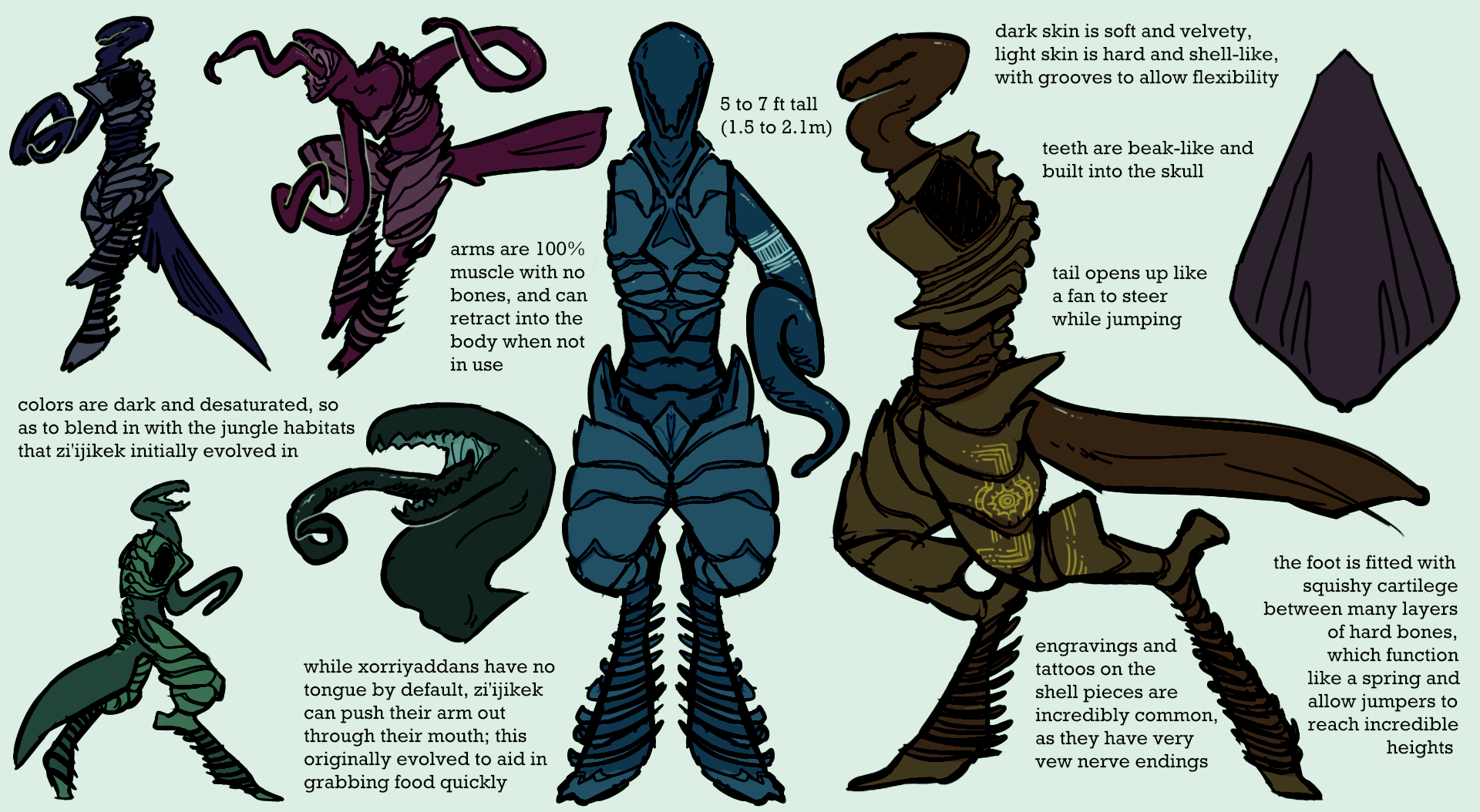
ZI'IJIKEK - "JUMPERS"
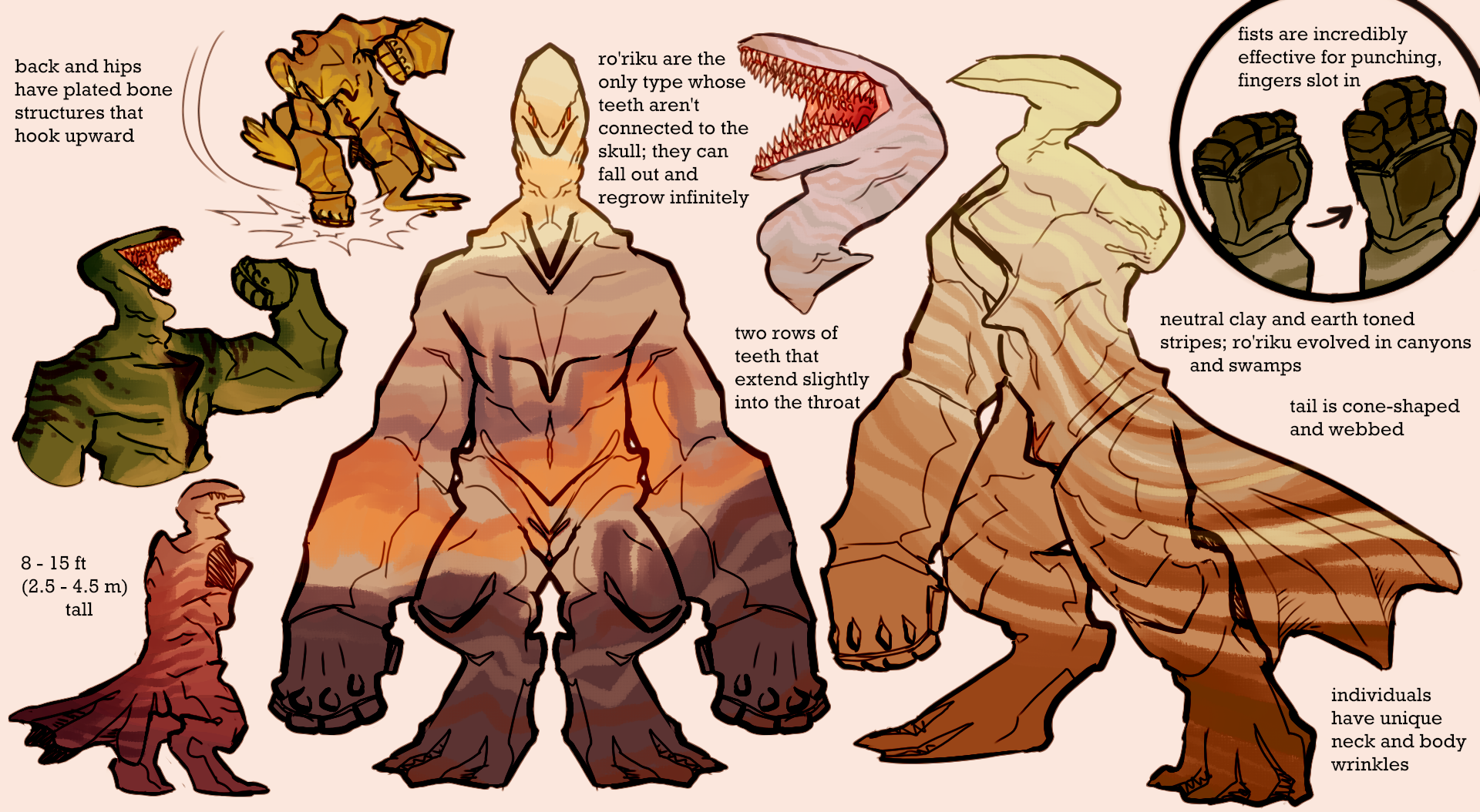
RO'RIKU - "FIGHTERS"
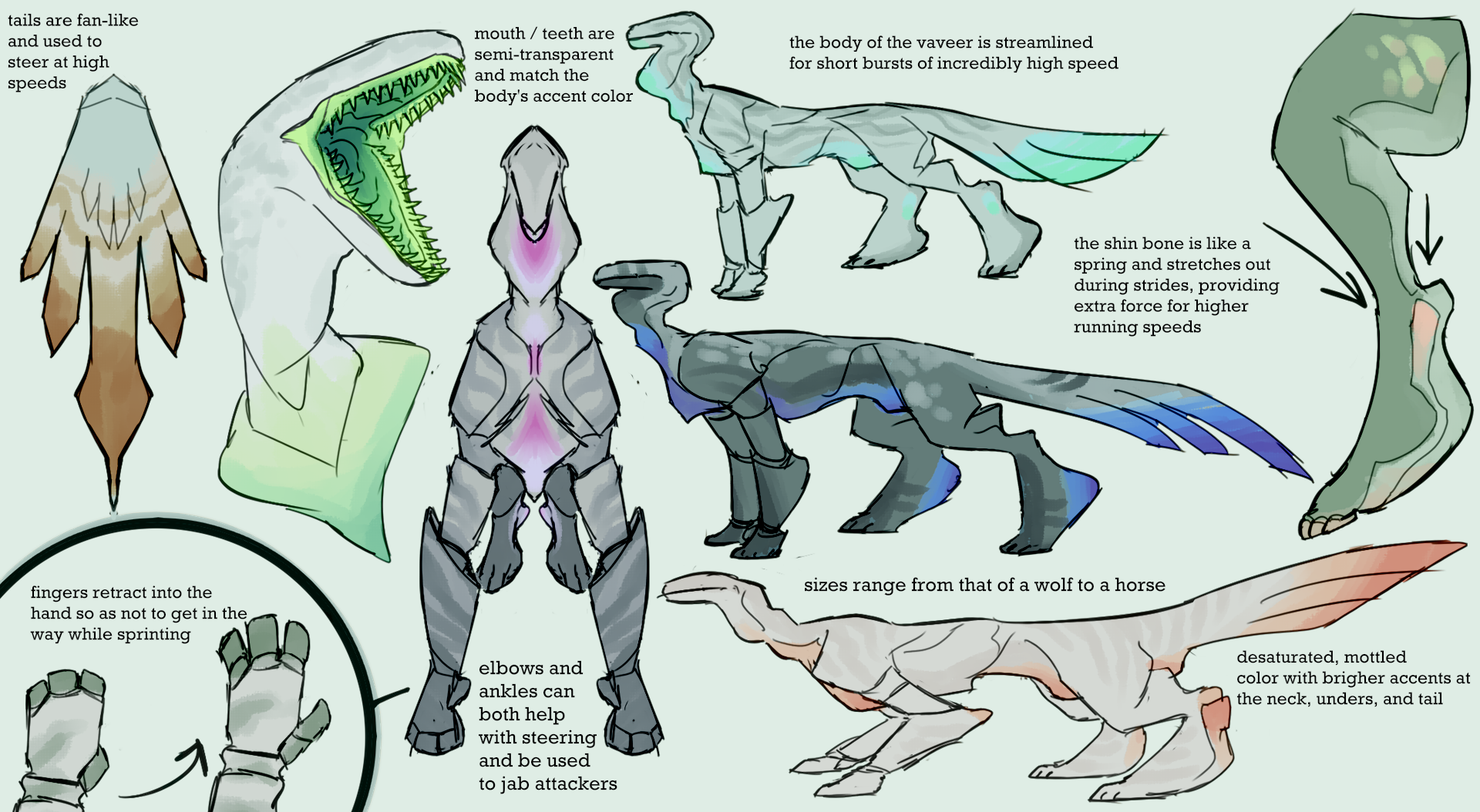
VAVEER - "RUNNERS"
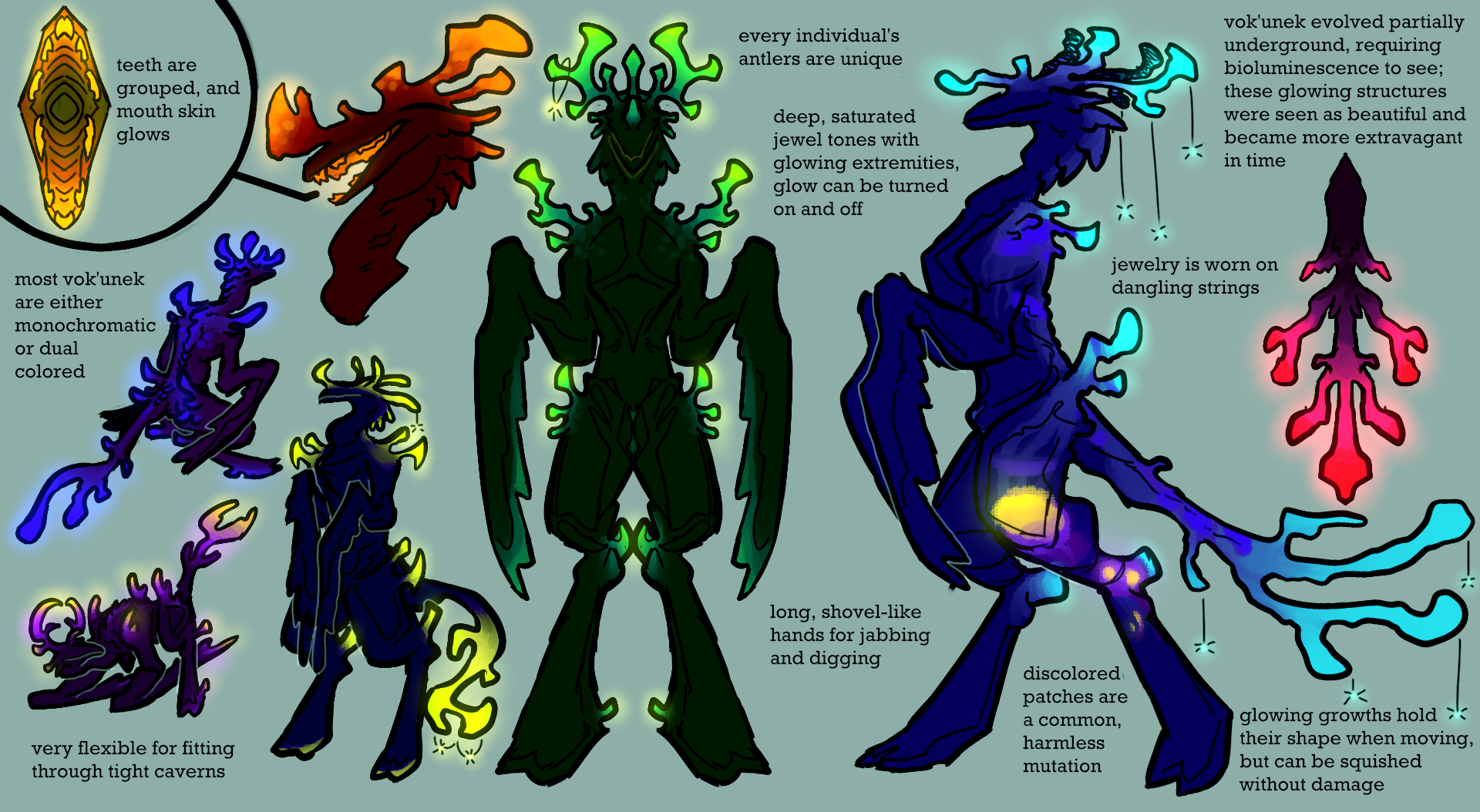
VOK'UNEK - "DIGGERS"
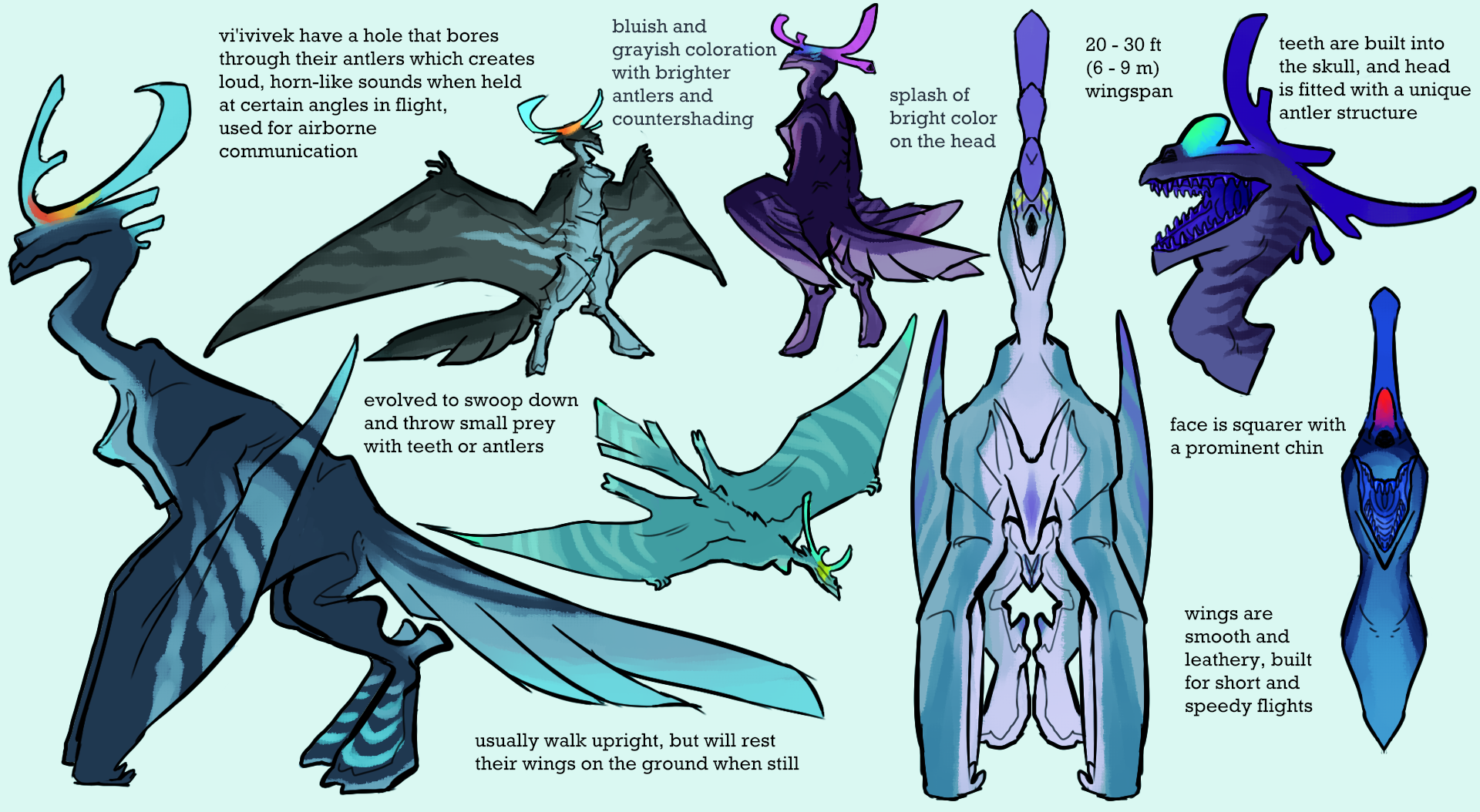
VI'IVIVEK - "GLIDERS"
All types are capable of having children together; they are genetically compatible. However, most children will inherit just one of the types. Visible hybridization is slightly uncommon, being a 1 in 10 chance. About one tenth of the Xorryaddan population are visibly hybrids between multiple types, meaning they possess a blend of physical traits from multiple types.
Of course, there is no stigma against being a visible hybrid, but it may present itself with unique challenges. For example, a ro'riku (fighter) and vi'ivivek (glider) hybrid may be incredibly tall, plus the edition of a huge antler atop the head. They may need to crouch slightly to fit through doors that a regular ro'riku would not need to worry about. Xorryaddan society at large is currently discussing this issue and budgeting for construction to enlarge spaces and doorways further for hybrid accessibility.

Xorryaddans tend to be incredibly number-smart, easily mastering advanced maths and sciences in their early teens. Similarly, puzzle games and character-driven mystery storytelling are extremely popular forms of Xorryaddan media.
Xorryaddans dust bathe regularly by rolling around in sand and dust; they do not need water to drink or to bathe in, nor do they breathe. Before mutating into radiotrophs, their skin absorbed the necessary chemicals from the air automatically upon contact, similarly to some insects on earth. Xors also occasionally mud bathe in certain types of volcanic mud to moisturize their skin and treat abrasions, sunburn, and dryness. Mud pools are present as outdoor attractions, often in scenic locations.
Because they barely ever eat solid food, they barely ever need to use the bathroom. Restrooms generally have one or two squat toilets, but are mostly used for dust bathing, featuring a large sandy pit and an area to wipe down so Xors don't track sand out into the rest of the building. The sand is replaced regularly.
Xorryaddans are all both sexes, thus they do not use gender or sexuality labels. Most Xors would not likely care how they are referred to in English, but I will be using neutral pronouns like "they" or "it" for them for clarity.
Kids are raised in large communes, in a few large nurseries per city, which are led by a group of adult nursery guides who teach the children about the world, math, science, medicine, engineering, socializing, the arts, politics, and other emphasized skills in society. But emphasis does not mean required; children who struggle with or don't enjoy the above subjects are free to do their own research and try new things.
Xorryaddan children act cat-like and animalistic for the first few years of their lives, skittering quickly, chirping, and climbing around on ledges, getting into places they shouldn't. Thus, nurseries must not have any high ledges and must have kid-proof doors and windows. They still have a strong prey drive left over from their initial evolution as predators, so they require tough chew toys and chase-like stimulation. As kids age, they will stand upright instead of running on all fours (except for vaveer, who are capable of standing upright, but will continue to walk on all fours often).
Though Xorryaddans do not have a concept of clothing, they will often wear tool belts and backpacks, variations of which are designed to be accessible for each type of Xor. It is incredibly uncommon to see Xorryaddans in clothing, even on Earth.

Buildings are constructed from black stone and clay spires, generally getting thinner towards the top. Streets are large and open, built with semi-soft clay for comfort, and are intended for walking and socializing, not vehicles. Within-city trams are suspended above the ground to ensure they do not intrude on the space of civilians below.
Residential buildings are many stories high, with the lowest stories belonging to ro'riku (fighters), and underground tunnels belonging to vok'unek (diggers). Middle stories for vaveer (runners) tend to have plenty of open space between rooms for sprinting. Mid-upper stories generally belong to zi'ijikek (jumpers), as they can quickly ascend buildings with little energy expense, often opting to hop up the stairs rather than take an elevator. The highest stories at the very top belong to vi'ivivek (gliders), as this allows them to quickly take flight by leaping out a window. It is very common for the types to live together in small communal groups, usually a group of friends or partners.
Buildings intended for research, the sciences, schools and universities, and other business-related endeavors are generally large and diamond shaped.
Most lighting is cyan in color, made from a concentrate from bioluminescent mushrooms. This gives cities an eerie black and blue look.
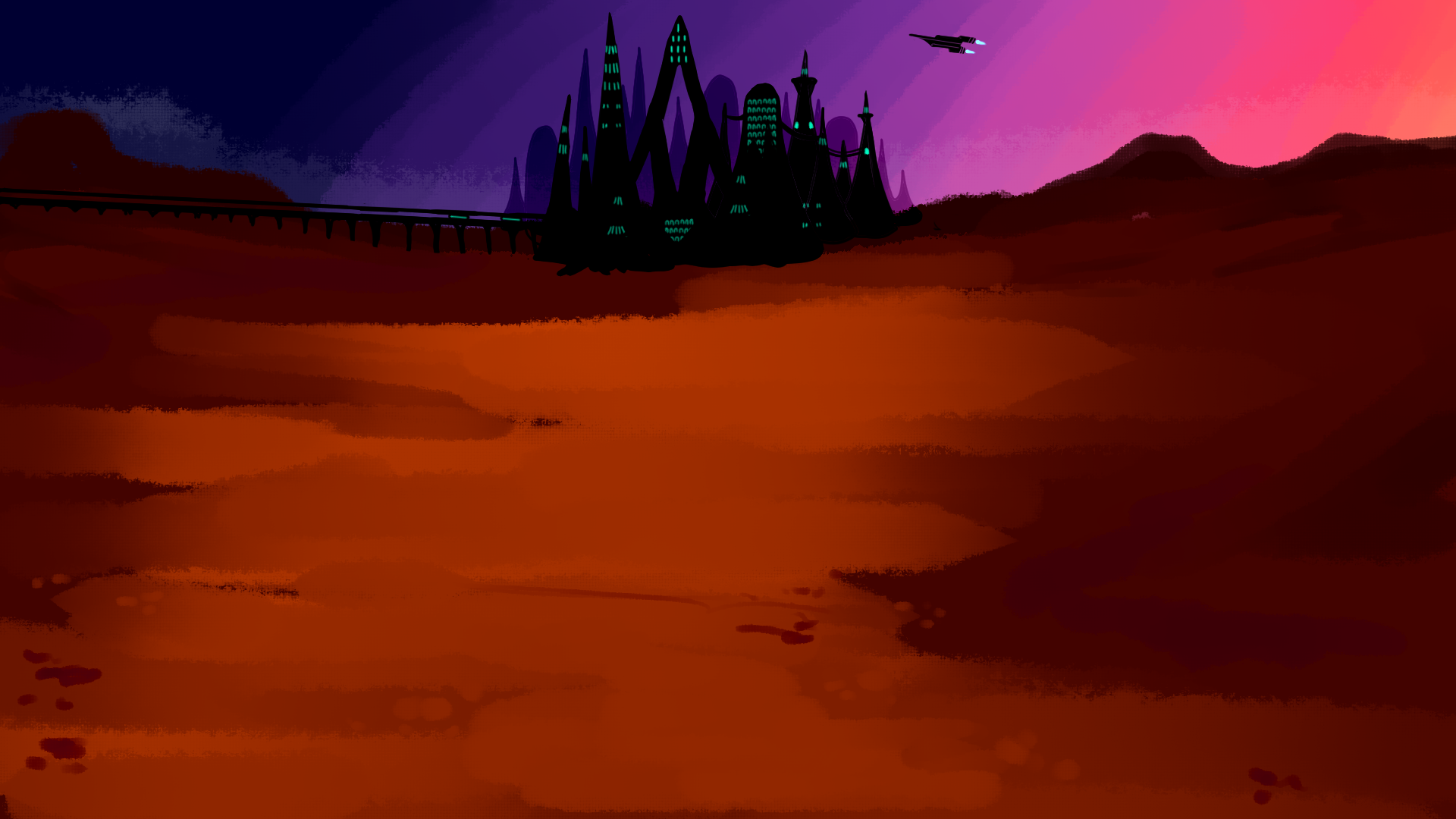
The neverending twilight of New Xorrya's habitable strip of land casts colorful lighting over everything.
Thorium nuclear reactors are present in the center of most large cities, so any waste that isn't recycled back into the reactor can be carried out into the city for distribution as food. Additional food as needed can be mined from radioactive elements in the planet's crust, especially uranium, though Xorryaddans are currently attempting to automate mining with machines as much as possible to avoid having to send civilians into caves that haven't proven to be 100% stable. Vok'unek are the most likely to become miners as they are incredibly comfortable underground!
Citizens can vote on issues local to their city directly on mobile devices, at public libraries, or on their at-home computers. Housing and medical equipment are distributed freely as needed, food is obviously free since radioactive materials can be placed at various locations in public and citizens will absorb it automatically, and issues can be openly discussed on a large public political forum. While the forum can be incredibly chaotic at times, most agree that it is important for direct democracy to remain fully functional, even in its roughest of patches. After all, politics is only such a rough topic because individuals have slightly different ideas of how they want to make the world a better place, a deeply important topic.
Most cities have large councils of about 100 members, who do not actually have much more power than the average citizen. The council members exist only to announce new issues to vote on, announce the winning vote on existing issues, and work towards putting those changes into action within city bounds. The 100 members come from different areas of the city, different backgrounds, abilities, Xor types, and varying skills and belief systems. They are expected to speak up if they feel that there is an issue impacting one group negatively in an unfair way. After two years, they must step down and be replaced by another similar citizen who can fill their place by being voted in.
Education is also free, and the most popular multi-year majors are various types of engineering, chemistry and physics, policial science, theoretical and applied mathematics, biology (of various species), mycology (as New Xorrya is mostly lifeless, but home to many types of mushrooms), ecology, psychology, medicine, architectural design, and computer science. Other popular training programs are construction work, welding, piloting spacecraft, dentists for ro'riku (fighters), mechanics for various types of craft & machinery, recyclers who collect trash & put it through the recycling process, mushroom farmers, web & game developers, the arts, & cooks (who make very small meals, hard candies, & flavor tablets).

Having no tongue, Xorryaddans speak in incredibly complex sets of clicks, chirps, vowel sounds, teeth clacks, rumbles, growls, huffs, and other similar sounds. Though to a human ear this may sound animalistic, Xorryaddan languages are the most complex in the known universe.
Some Xor languages use more screeches and trills, while others use more deep guttural sounds. Some are musical in nature and require singing to convey intent and tone.
Creatures with humanoid vocal cords are completely incapable of speaking any Xorryaddan languages, as they are physically incapable of making the required sounds. Xorryaddans speaking Daejiin, common draconic, any human language, or any Pyrexian language will have a heavy accent and be unable to produce sounds that require a tongue. In most cases though, they can be understood. Some Xorryaddans use a vocal translator app as a piece of worn mobile tech.

Click below to expand the reproductive biology tab. Biological discussion of an egg-laying species ahead!
All individuals possess both a penis (that also functions as an ovipositor), and a vagina. They cannot self-fertilize. The genitals are held inside a Y-shaped slit when unaroused.
Upon orgasm, individuals will ejaculate dozens of glass-like, translucent unfertilized eggs. If laid inside another individual's vaginal canal, the eggs will be taken up into a pouch-like organ where they will become fertilized, growing in size before being laid again 1 to 3 days later.
LINK
A visual illustration; NSFW IMAGE WARNING. Requires a FurAffinity account to view.
After laying, Xorryaddans feel no emotional attachment to their eggs whatsoever; they are generally thrown into the town's nursery and never thought about again. Other species often find this a bit shocking. However, evolution has made it so Xorryaddans are capable of producing hundreds of eggs per year. Upwards of 90% of these eggs will not form a fetus and hatch successfully, but just enough will succeed that the species will be able to continue with a healthily rising population. In terms of eggs, evolution pushed toward quantity over quality.
Eggs can take upwards of 10 years to hatch, as the fetus forms inside incredibly slowly, feeding off radiation in the environment. This also gives the child ample time to develop working limbs and basic intelligence, so once hatched, they will immediately be able to run around.
Birth control can be taken to prevent eggs from becoming fertilized, if desired. Some birth controls prevent the forming of eggs in the ovipositor altogether, while others only prevent their fertilization once inside the vaginal canal. Most Xors who use eggless birth control do so simply because it can be a bit inconvenient to be carrying eggs while going about your day.

There might be more than five types of Xorryaddans. It is possible, though incredibly rare, for children to be born as a type of Xor that does not match their parents. There have even been a few cases of children being born an unrecognizable type of Xor that was thought to have died out early in their evolution millions of years ago. The most notable of this is the semiaquatic type, of which there are currently only four individuals in the world. The semiaquatic type is not quite suited for life on New Xorrya, without the presence of any water, but its reintroduction has been incredibly interesting for genealogists and Xorryaddan historians alike. Experts claim that the DNA of semiaquatic Xorryaddans must have been carried down through the generations and, though some genetic glitch, has suddenly reappeared. It is likely that the population of semiaquatic types will continue to increase as long as those in the family continue to have children.
Xorryaddans who travel to Earth to assist in the revolt against the Provinces, or to Pyrexia for travel/visit/trade, have to go through a process of cleaning to ensure they won't expose other species to harmful amounts of radiation. They will need to be kept in a locked space with no significant ionizing radiation for a few hours until their bodies have absorbed all the leftover radiation in the area. This can be quite boring, so virtual reality headsets and videogames are sometimes installed in these locations.
Having access to incredibly advanced fusion technology, Xorryaddans have reached the continent of stability and have access to stable superheavy metals far beyond the human periodic table. An incredibly thin layer of these lines the walls of any Xorryaddan-owned homes and buildings on Earth and Pyrexia, so that harmful amounts of radiation do not leak out into the environment.
